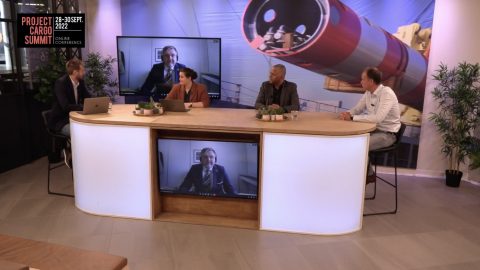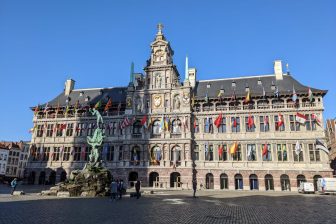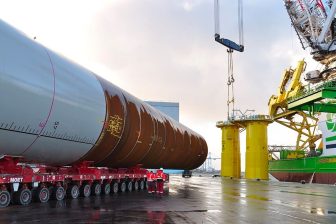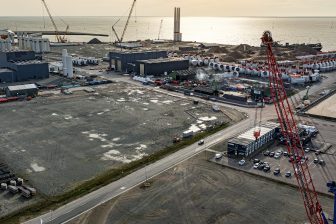
Project Cargo Summit: Ports facilitating the energy transition
With the European Union looking to cut dependency on Russian fossil fuels and expediting its green energy agenda, European ports are preparing for an uptick in offshore wind project cargo as well as volumes related to the hydrogen industry. During the 2022 Project Cargo Summit, three representatives from three different ports gathered for a panel discussion on the role ports can play in the energy transition.
Danny Levenswaard, Director of Breakbulk at the Port of Rotterdam, Daan Van Velzen Commercial Manager of Logistics for Team Cargo at the Port of Amsterdam, and Jesper Bank, Chief Commercial Officer at Port Esbjerg, sat down, to discuss the role ports can play in facilitating the energy transition, as well as the challenges they are facing and solutions to potentially overcome them.
Offshore wind
One way in which ports contribute to the energy transition, is by facilitating renewable energy projects, such as the construction of offshore wind farms (OWF). In the Danish port, there has been an increase in offshore wind (OW) industry cargo overall, despite hiccups in the supply chain and lack of affordable steel. Jesper Bank stated that “There has been a very small decrease in Esbjerg in the short run, but looking forward, we get sweaty. From 2023 on, things will really begin to speed up. In that sense we are positive.”
The same is true for Rotterdam: “We see a lot of business coming from offshore wind. Out of Rotterdam, we’ve served the offshore wind projects happening in the North Sea.” comments Danny Levenswaard. The Port of Amsterdam has serviced onshore wind projects in the hinterland, and is currently working on the Averijhaven, a marshalling terminal outside of the sealock in Amsterdam, also focussed on the offshore wind industry. “It will be about 15 hectares. That will be a good opportunity for us to expand in the offshore wind industry and work on the installation of windparks, but one of the next steps is Operations and Maintenance (O&M). That’s one of the major focus points for us out of Amsterdam and IJmuiden.” said Daan Van Velzen.
Challenges of scale
As a port, handling the cargo needed for the construction and O&M of OWFs does not come without its share of challenges. “Operators like to work out of one single port, and projects are necessitating increasing amounts of skill and know-how, but also of space, and reinforced infrastructure that can handle the cargo weight,” adds Danny Levenswaard. Indeed “Everything is still sizing up, not just the turbines or tower sections but everything involving them, such as the vessels, the trucks…” says Bank.
“At the same time we see that the need for speed in putting up turbines is extremely high.” This is related to the Ukraine conflict and the EU’s desire to achieve energy independence and security. “We have a port expansion plan of 50 hectares here in Esbjerg, and even now we know that that will be far too little,” he continues. The scale of projects, and speed at which they are being developed is therefore a challenge that ports are currently facing, which will continue to be exacerbated for the foreseeable future. As stated by Bank, “The ambitions are much higher. We are driving on a bike path when what we need is a freeway.”
Making space for industry frontrunners
In addition to supporting OW projects, ports can support companies that are themselves contributing to the energy transition. This can include companies working on the development of biofuels, hydrogen production and storage, and other such technologies. For the Port of Amsterdam, “It’s a move from being a fossil port to a non fossil port.” Working with companies towards mutually beneficial solutions will be necessary. Port companies can focus on new fuels, or hydrogen. “We’re working on a bio-park in our port for example,” says Daan Van Velzen.
But in a context where new industries need to be developed as the old are phased out in the same environment, space becomes a pervasive problem, explains Van Velzen: “Making space is very difficult. We’ve seen a rising demand for space in the last 5 years. Now we need to look into the next 25 to 50 years. You need the space to build the infrastructure and facilitate the companies. You need to work with what you have right now, and sometimes relocate businesses that have been there for 50 years, to facilitate the transition.”
This is particularly true in ports like Amsterdam’s which are confined in their growth by urban areas. “We do have the same constraints. One thing that we are focusing on, being a smaller port, is efficiency. As a port, with a landlord function, or as an infrastructure provider, we dialogue with our customers about the most efficient way to use port capacity.” says Jesper Bank.
Prioritising investment
In addition to needing increased space and capacity to handle larger OW projects, and attract as well as support industry frontrunners, ports need to invest in appropriate infrastructure. As Levenswaard stated: “Ports need to make sure the infrastructure is there: having CO2 or hydrogen pipelines, shore power, space for wind farm components, but also to attract companies that are frontrunners in the energy transition…” As Bank commented, “We want to be a port on the forefront. We take these investments with the risks and even sometimes with the losses, because we know that in five years, ten years, you need to be there.”
Danny Levenswaard highlights a tendency to go towards greener energy systems: “as a port you can take a look at your own assets. The Rotterdam port’s patrol fleet runs on more sustainable energy sources, some on hydrogen already. We try to electrify as much as possible.” But ports can also include sustainability goals in new contracts with all kinds of actors. “When we contract a new project, we add sustainability goals to the contract so that the contractor also performs his operations in a more sustainable way.” adds Levenswaard.
Collaboration is key
Ports may also need to devise new infrastructures to share power and resources. Coexisting and sharing areas will be needed to increase capacity within the existing frames. Levenswaard explains: “In Rotterdam, we try to break up the path towards net-zero. We can start by making the existing system more efficient. Ports already use each others’ products, but we could increase this, sharing CO2 for example. We make our way to a new energy system, a new kind of infrastructure, to become a net-zero industry, but it will take quite some time.”
Cooperation with inland ports is also important. Both the ports of Rotterdam and Amsterdam have an MoU with the port of Duisburg to build a hydrogen supply and value chain for example. “You can’t just do it on your own,” says Daan Van Velzen. “Collaboration, cooperation, and dialogue will be key, to create more capacity for more energy. We can’t have it all in Esbjerg, that is for sure,” concures Bank. A good example of resource sharing inclusions.
Lastly, Port Esbjerg has spearheaded the creation of a partnership between the six key ports for offshore wind in Northern Europe, including Esbjerg, Port Oostende (Belgium), Groningen Seaports/Eemshaven (Netherlands), Niedersachsen Port/Cuxhaven (Germany), Nantes-Saint Nazaire Port (France) and Humber (UK). Looking forward, it will be interesting to see what other such partnerships may develop, globally and in Europe.



